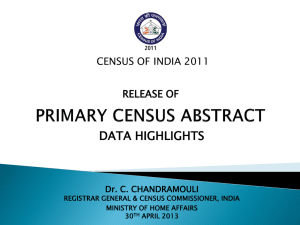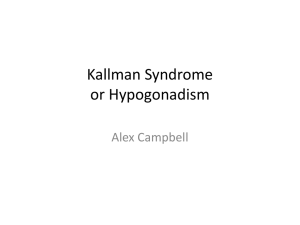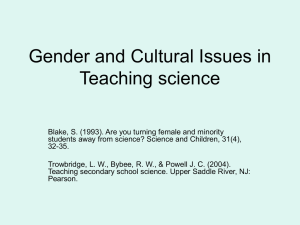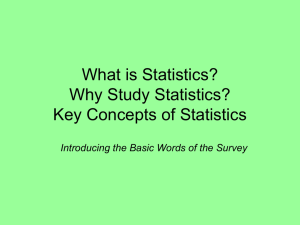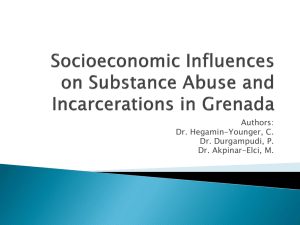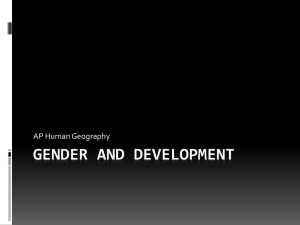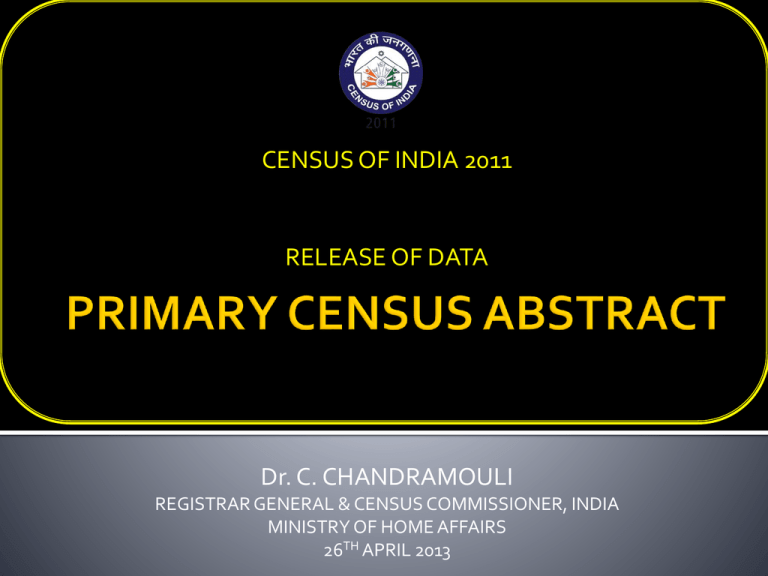
CENSUS OF INDIA 2011
RELEASE OF DATA
Dr. C. CHANDRAMOULI
REGISTRAR GENERAL & CENSUS COMMISSIONER, INDIA
MINISTRY OF HOME AFFAIRS
26TH APRIL 2013
• This is the first set of data released from the Population
Enumeration exercise held in February 2011
• So far the data released from Census 2011 pertained to
Houselisting and Housing Census covering
• All Households
• SC & ST Households
• Female Headed Households
• Slum Households
• On 31st March 2011, just after 25 days of completion of
the Population Enumeration phase, PROVISIONAL
POPULATION TOTALS of the Country, State & other
levels administration level released
• Today the FINAL POPULATION TOTALS are released
along with information on few other characteristics
• This has been possible as the first stage of data capture
and data processing have been completed in record
time.
• Stages of work involved:
• 340 million Schedules in 16 languages
• Return collection of filled-in Census Schedules
• Inventory management
• Scanning
• Data Recognition using Intelligent Character
Recognition (ICR) technology
• Data Processing
• Generation of Tables
• Number of Households
• Population*
• Population (0-6)*
• Number of Literates*
• Scheduled Castes Population
• Scheduled Tribes Population
• Number of Workers (Total, Main, Marginal)
• Category of Workers (Cultivators, Agricultural Labourers,
Household Industry Workers, Other Workers)
* - Provisional data released earlier
By Sex & Residence
Census of India 2011
• In India there are 24.95 crore (2,495 million)
households as per Census 2011
• The number has increased by 5.58 crore over the
last Census held in 2001
• Largest number of households are in Uttar Pradesh
(3.34 crore).
• There are 10 States where more than one crore
households have been returned.
• Final Total Population of the country is
1,210,569,573 (or 1.21 billion)
• Provisional Population Total:
1,210,193,422
• There is a marginal increase of 376,151
persons in the country’s population in the
Final Population compared to Provisional
Population.
(In millions)
Total
Rural
Urban
Final Population 2011
1210.6
833.5
377.1
Provisional
Population 2011
1210.2
833.1
377.1
+0.4
+0.4
0.0
Difference
POPULATION
(IN MILLION)
Top 5 States/UTs
Bottom 5 States/UTs
Uttar Pradesh
199,812,341
Sikkim
610,577
Maharashtra
112,374,333
A. & N. Islands
380,581
Bihar
104,099,452
D. & N. Haveli
343,709
West Bengal
91,276,115
Daman & Diu
243,247
Andhra Pradesh
84,580,777
Lakshadweep
64,473
Top 5 Districts
Bottom 5 Districts
Thane (Maharashtra) 11,060,148
Nicobars (Andaman &
Nicobar Islands)
36,842
North Twenty Four
Parganas (West
Bengal)
10,009,781
Upper Siang (Arunachal
Pradesh)
35,320
Bangalore
(Karnataka)
9,621,551
Lahul & Spiti (Himachal
Pradesh)
31,564
Pune (Maharashtra)
9,429,408
Anjaw (Arunachal
Pradesh)
21,167
Mumbai Suburban
(Maharashtra)
9,356,962
Dibang Valley
(Arunachal Pradesh)
8,004
• 833 million persons live in Rural areas, which is
more than two-third of the total population
• Rural – Urban distribution : 68.8% & 31.2%
• Level of Urbanization increased from 27.81% in
2001 Census to 31.2% in 2011.
• The proportion of Rural population declined from
72.19% to 68.8%
• Among the States/UTs in India the level of
Urbanization (proportion of urban population to
total population) in Census 2001 is highest in NCT
Delhi (97.5%)
• Top five most urbanized States (excl UTs):
• Goa
• Mizoram
• Tamil Nadu
• Kerala
• Maharashtra
62.17%
52.11%
48.40%
47.70%
45.22%
PROPORTION
OF URBAN
POPULATION
(IN %)
Decadal Growth in Population:
• Population of India grew by 17.7% during 2001-11
• In the previous decade the growth rate was 22.7%
• Thus, there has been a substantial decline in the
growth of population of India
• Among the major States, highest decadal growth in
population has been recorded in Bihar (25.4%)
• 14 States/UTs have recorded population growth above
20%.
Growth in Population:
• There has been an increase of 181.96 million persons
in the absolute number of population in India during
2001-11
• Increase among males:
90.97 million
• Increase among females: 90.99 million
• Growth Rate in population among females (18.3%) is
higher than among males (17.7%) during the last
decade.
DECADAL
GROWTH IN
POPULATION
(IN %)
• In 20 States/UTs growth in female population during 2001-11
exceeds growth in male population in absolute terms
• Top 5 among these States are:
Andhra Pradesh (541,304), Kerala (447,091), West Bengal
(413,834), Tamil Nadu (267,219), Assam (225,236)
• This could be due to better enumeration of females in Census
2011 and improvement in preventing female mortality
• On the other hand, Bihar, Gujarat, Rajasthan, Uttar Pradesh
and Maharashtra showed significant higher growth among
males than females.
2001
2011
Difference
Variation
(in %)
16,38,19,589
16,44,78,150
658,561
+0.4
Males
8,49,99,186
8,57,32,470
733,284
+0.8
Females
7,88,20,403
7,87,45,680
-74,723
-0.09
Persons
PROPORTION
OF CHILD
POPULATION
(IN %)
• The total number of children in India in the age-group 0-6
years, as per the final population totals of Census 2011, is
16.45 crore, about 6.6 lakh less than the number recorded
in 2001
• Though there is increase in Male Child (0-6) population,
population of Female Child (0-6) has actually decreased
marginally between 2001 & 2011
• Twenty States and Union Territories now have over ten
lakh children in the age group 0-6 years each.
• In ten States/UTs the number of children in the age-group
0-6 years are between 1 to 9 lakh.
(In millions)
Total
Males
Females
2011 Census
1210.6
623.1
587.5
2001 Census
1028.6
532.2
496.5
+17.7
+17.1
+18.3
Growth 2001-11
(%)
(In crore)
Total
Males
Females
2011 Census
16.45
8.57
7.87
2001 Census
16.38
8.50
7.88
Growth 2001-11
(%)
+0.40
+0.86
-0.09
• The total number of children in India in the age-group 0-6
years, as per the final population totals of Census 2011, is
16.45 crore, about 6.6 lakh less than the number recorded
in 2001
• Though there is increase in Male Child (0-6) population,
population of Female Child (0-6) has actually decreased
marginally between 2001 & 2011
• Twenty States and Union Territories now have over ten
lakh children in the age group 0-6 years each.
• In ten States/UTs the number of children in the age-group
0-6 years are between 1 to 9 lakh.
• Sex ratio is defined as the number of females per 1000
males in a population.
• It is an important indicator to measure the extent of
prevailing equity between males and females at a given
point of time.
Residence
2001
2011
Change
Total
933
943
+10
Rural
946
949
+3
Urban
900
929
+29
SEX RATIO
Top 5 States/UTs
States/UTs
Bottom 5 States/UTs
Sex Ratio
States/UTs
Sex Ratio
Kerala
1,084
Andaman & Nicobar Is
878
Puducherry
1,038
NCT of Delhi
866
Tamil Nadu
995
Chandigarh
818
Andhra Pradesh
992
Dadra & Nagar Haveli
775
Manipur
987
Daman & Diu
618
* Sex Ratio is defined as the number of females per 1000 males
• The sex ratio in the age group 0-6 attempts to bring out the
recent changes in our society in its attitude and outlook
towards the girl child.
• It provides a broad indicator reflecting ground realities as
they exist in the society and more importantly is an
indicator of the likely future trends of sex ratio of the
population.
Residence
2001
2011
Change
Total
927
919
-8
Rural
934
923
-11
Urban
906
905
-1
CHILD
SEX RATIO
Top 5 States/UTs
Bottom 5 States/UTs
States/UTs
Sex Ratio
(0-6 yrs)
Arunachal Pd
972
Chandigarh
880
Mizoram
970
NCT of Delhi
871
Meghalaya
970
Jammu & Kashmir
862
Chhattisgarh
969
Punjab
846
A. & N Islands
968
Haryana
834
States/UTs
Sex Ratio
(0-6 yrs)
* Child Sex Ratio (0-6) is defined as the number of females per 1000 males in the
age group 0-6 years.
• A person is considered literate if he or she can read and
write, with understanding, in any language.
• Literacy rate: The total percentage of the population of an
area at a particular time aged seven years or above who can
read and write with understanding. Here the denominator
is the population aged seven years or more.
(in crore)
Sex
2001
2011
Change
Persons
56.07
76.35
+20.28
Males
33.65
43.47
+9.82
Females
22.42
32.88
+10.46
(in %)
2001
2011
Difference
(2011 – 2001)
Persons
64.8
73.0
+8.2
Males
75.3
80.9
+5.6
Females
53.7
64.7
+10.9
Residence Sex
2001
2011
Change
Rural
Persons
58.7
67.8
+ 9.1
Males
70.7
77.2
+ 6.5
Females
46.1
57.9
+ 11.8
Gender Gap
24.6
19.3
Persons
79.9
84.1
+ 4.2
Males
86.3
88.2
+ 1.9
Females
72.9
79.1
+ 6.2
Gender Gap
13.4
9.1
Urban
• The Literacy Rate of the population of the country has
increased by 8.2 percentage points from 64.8% to 73.0% over
2001-11
• The largest increase in Literacy Rate has been recorded in
• Dadra & Nagar Haveli by 18.6 points (from 57.6% to 76.2%)
• Bihar by 14.8 points (from 47.0% to 61.8%)
• Tripura by 14.0 points (from 73.2% to 87.2%)
• Highest increase in Female Literacy Rate has been reported
from Dadra & Nagar Haveli (by 14.0 points)
• Nagaland and Bihar also recorded high increase in Female
Literacy Rate in Census 2011 compared to 2001.
(In %)
Top 5 States/UTs
States/UTs
Kerala
Bottom 5 States/UTs
Literacy
Rate
94.0
States/UTs
Andhra Pradesh
Literacy
Rate
67.0
Lakshadweep
91.8
Jharkhand
66.4
Mizoram
91.3
Rajasthan
66.1
Tripura
88.7
Arunachal Pradesh
65.4
Goa
87.2
Bihar
61.8
• Scheduled Castes are notified in 32 States/UTs of India and
Scheduled Tribes in 30 States
• There are altogether 99999 individual ethnic groups or parts
thereof notified as Scheduled Castes in different States/UTs
• Number of individual ethnic groups or parts thereof notified as
Scheduled Tribes is 99999
• There has been some changes in the List of SCs/STs in States/
Uts.
2001
2011
Variation
(%)
166,635,694
201,378,086
+20.8
Males
86,088,757
103,535,165
+20.3
Females
80,547,930
97,842,921
+21.5
Persons
2011
Variation
(%)
Persons
8,43,26,978 10,42,81,034
+23.7
Males
4,26,41,217
5,24,09,823
+22.9
Females
4,16,85,761
5,18,71,211
+24.4
Sex
2001
(In %)
Total Population
Proportion of Proportion of
SCs
STs
Total
1,210,569,573
16.6
8.6
Rural
833,463,448
18.5
11.3
Urban
377,106,125
12.6
2.8
Top 5 States/UTs
Bottom 5 States/UTs
Punjab
31.9%
Daman & Diu
2.5%
Himachal Pradesh
25.2%
Dadra & Nagar Haveli
1.8%
West Bengal
23.5%
Goa
1.7%
Uttar Pradesh
20.7%
Meghalaya
0.6%
Haryana
20.2%
Mizoram
0.1%
Top 5 States/UTs
Bottom 5 States/UTs
Lakshadweep
94.8%
Uttarakhand
2.9%
Mizoram
94.4%
Kerala
1.5%
Nagaland
86.5%
Bihar
1.3%
Meghalaya
86.1%
Tamil Nadu
1.1%
Arunachal Pradesh
68.8%
Uttar Pradesh
0.6%
1. Work is defined as participation in any economically
productive activity with or without compensation,
wages or profit.
2. Participation may be physical and/or mental in
nature.
3. Work involves not only actual work but also includes
effective supervision and direction of work.
4. It even includes part time help or unpaid work on
farm, family enterprises or in any other economic
activity.
5. The important point to note is that the. activity
should be economically productive
Worker: A person who has participated in any economically
productive activity at any time during the reference
period (one year preceding the date of enumeration).
Residence
Total
Population
Work
Number of
Participation
Workers
Rate*
Total
1,210,569,573
481743311
39.8%
Rural
833,463,448
348597535
41.8%
Urban
377,106,125
133145776
35.3%
* - Work Participation Rate is defined as the number of workers per
100 population
(In %)
Residence Sex
2001
2011
Change
Total
Persons
39.1
39.8
+0.7
Males
51.7
53.3
+1.6
Females
25.6
25.5
-0.1
(In %)
Residence Sex
2001
2011
Change
Rural
Persons
41.7
41.8
+0.1
Males
52.1
53.0
+0.9
Females
30.8
30.0
-0.8
Persons
32.3
35.3
+3.0
Males
50.6
53.8
+3.2
Females
11.9
15.4
+3.5
Urban
Range (Work Participation
Rate) (in %)
2001
2011
Change
Up to 10.0
0
0
0
10.1 - 20.0
0
0
0
20.1 - 30.0
1
1
0
30.1 - 40.0
17
16
-1
40.1 - 50.0
15
16
+1
50.1 - 60.0
2
2
0
Above 60.0
0
0
0
Total
35
35
Persons
Range (Work Participation
Rate) (in %)
2001
2011
Change
Males
Up to 10.0
0
0
0
10.1 - 20.0
0
0
0
20.1 - 30.0
0
0
0
30.1 - 40.0
0
0
0
40.1 - 50.0
11
8
-3
50.1 - 60.0
22
24
+2
Above 60.0
2
3
+1
35
35
Total
Range (Work Participation
Rate) (in %)
2001
2011
Change
Females
Up to 10.0
2
0
-2
10.1 - 20.0
9
13
+4
20.1 - 30.0
9
8
-1
30.1 - 40.0
13
12
-1
40.1 - 50.0
2
2
0
50.1 - 60.0
0
0
0
Above 60.0
0
0
0
35
35
Total
•
Main worker: Person who had ‘worked’ for 6 months or
more during the reference period
•
Marginal worker: Person who had ‘worked’ for less than 6
months
•
Non-worker: Person who did not ‘work’ at all during the
reference period (code 4). They will include students,
persons engaged in household duties, dependents,
pensioners, beggars, etc.
Persons
Males
Females
(in %)
Residence
Sex
2001
2011
Change
Main Workers
Persons
77.8
75.2
-2.6
Males
87.3
82.3
-5.0
Females
57.3
59.6
2.3
Persons
22.2
24.8
2.6
Males
12.7
17.7
5.0
Females
42.4
40.4
-2.3
Marginal Workers
Total Workers
• The Proportion of Total Workers in the country has
recorded a marginal increase from 39.1% in 2001 to
39.8% in 2011
• Majority of the States/ UTs have shown increase in the
proportion of total workers between 2001-2011,
• However, in 9 States/UTs, this proportion has actually
declined during the decade (Mizoram (-8.2 percentage
points), D & N Haveli, Haryana, Jammu & Kashmir,
Meghalaya, Punjab, Arunachal Pradesh, Gujarat, Bihar
(-0.3 pp).
(in %)
Total Workers
State
2001
2011
Change
1. Mizoram
52.6
44.4
-8.2
2. D & N Haveli #
51.8
45.7
-6.0
3. Haryana
39.6
35.2
-4.4
4. Jammu & Kashmir
37.0
34.5
-2.5
5. Meghalaya
41.8
40.0
-1.9
6. Punjab
37.5
35.7
-1.8
7. Arunachal Pradesh
44.0
42.5
-1.5
8. Gujarat
41.9
41.0
-1.0
9. Bihar
33.7
33.4
-0.3
Main Workers
• The proportion of Main Workers in the country has
declined by 2.6 percentage points between 2001 & 2011
• In 23 States/ UTs this proportion has declined, the
prominent among them are: Lakshadweep (by 18.7
percentage point), Bihar (by 13.7 pp) and Jharkhand (by
11.7 pp)
• Decline in proportion of main workers in such a large
number of States needs further exploration.
Marginal Workers
• The Proportion of Marginal Workers in the country has
increased by 2.6 percentage points from 22.2% to 24.8%
between 2001 & 2011
• Majority of the States/UTs have shown increase in the
proportion of Marginal Workers during the last decade
• In 10 States/ UTs this proportion has declined, including
Mizoram (by 7.7 pp), Haryana, Maharashtra, Gujarat,
Karnataka pointing to reversal of trend.
Total Workers
(Main + Marginal)
• Cultivators
1,187 lakh
(24.6%)
• Agricultural Labourers
1,443 lakh
(30.0%)
183 lakh
( 3.8%)
2,004 lakh
(41.6%)
• Household Industries Workers
• Other Workers
Residence
Sex
Main Marginal
Worker
Worker
Total
Worker
Number of Cultivators (in lakh)
All Areas
Persons
958
229
1187
Males
730
97
827
Females
228
132
360
Proportion of Cultivators among Workers (in %)
All Areas
Persons
26.4
19.2
24.6
Males
26.7
16.5
24.9
Females
25.6
21.7
24.0
Residence
Sex
Main Marginal
Worker
Worker
Total
Worker
Number of Agricultural Labourers (in lakh)
All Areas
Persons
862
582
1443
Males
553
275
827
Females
309
307
616
Proportion of Agricultural Labourers among Workers (in %)
All Areas
Persons
23.8
48.8
30.0
Males
20.2
46.8
24.9
Females
34.6
50.6
41.1
Residence
Sex
Main Marginal
Worker
Worker
Total
Worker
Number of HHI Workers (in lakh)
All Areas
Persons
123
60
183
Males
75
22
98
Females
48
38
86
Proportion of HHI Workers among total workers (in %)
All Areas
Persons
3.4
5.0
3.8
Males
2.8
3.8
2.9
Females
5.4
6.2
5.7
Residence
Sex
Main Marginal
Worker
Worker
Total
Worker
Number of Other Workers (in lakh)
All Areas
Persons
1681
323
2004
Males
1373
193
1566
308
130
437
Females
Proportion of Other Workers among total workers (in %)
All Areas
Persons
46.4
27.1
41.6
Males
50.3
32.9
47.2
Females
34.5
21.4
29.2
(in %)
Residence
Category
2001
2011
Change
100.0
100.0
Cultivators
31.7
24.6
- 7.1
Ag. Labourers
26.5
30.0
+3.4.
4.2
3.8
-0.4
37.6
41.6
+4.0
Workers (Main + Marginal)
All Areas
Total Workers
HHI Workers
Other Workers
(in %)
Residence
Category
2001
2011
Change
100.0
100.0
Cultivators
40.2
33.0
-7.2
Ag. Labourers
33.0
39.3
+6.3
3.9
3.4
-0.5
22.8
24.3
+1.5
Workers (Main + Marginal)
Rural
Total Workers
HHI Workers
Other Workers
(in %)
Residence
Category
2001
2011
Change
100.0
100.0
Cultivators
2.8
2.8
0.0
Ag. Labourers
4.7
5.5
+0.8
HHI Workers
5.2
4.8
-0.4
87.3
86.9
-0.4
Workers (Main + Marginal)
Urban
Total Workers
Other Workers
Thank you
http://www.censusindia.gov.in


